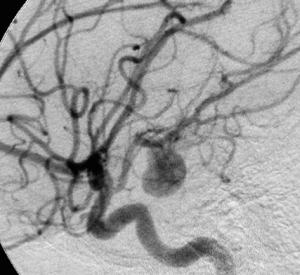Aneurysm and Headache: 9 Ways to Know if I’m in Danger
When many people think of an aneurysm (or aneurism), they think of a severe headache and severe danger. Although aneurysms aren’t always like that, it is important to be aware of how headache and aneurysm can relate.
An aneurysm is an abnormal ballooning or widening of an artery. That means they can actually happen in many parts of the body, though some locations are more likely than others. Though no one is certain what causes all aneurysms, there are cases when they may be caused by a defect in the artery wall. High blood pressure, high cholesterol, smoking, drug abuse, and pregnancy are all common risk factors.
Sometimes aneurysms don’t cause any symptoms at all, but simply show up when you’re being tested for something else. At times your doctor won’t even recommend you have it treated.
 An Angiograph of a Brain Aneurysm Photo courtesy of Lucien Monfils |
The most common type of aneurysm related to headache is the brain aneurysm. The bulge in a blood vessel in the brain may grow, leak, or rupture.
If the aneurysm is small, or even large, there may be no symptoms at all. If an aneurysm like this is discovered, you’ll need to talk to your doctor about whether or not treatment is needed.
If there are symptoms, they might include:
- Pain – usually above or behind an eye
- A drooping eyelid (which may also be a symptom of cluster headache)
- A dilated pupil
- Change in vision (ie double vision)
- Numbness or weakness on one side of the face
You need to see your doctor if you’re experiencing these symptoms.
If the aneurysm begins to leak, or ruptures, that’s when it becomes an emergency (if it ruptures you need to get to a doctor NOW). But how do you tell?
- Sudden, severe headache. This may happen with a leak (which usually becomes a rupture) or an actual rupture. If you have a sudden headache, perhaps the worst you’ve ever had, get to a doctor right away.
- Nausea (also common in migraine, of course)
- Sensitivity to light (another very common migraine symptom)
- Stiff neck
- Blurred or double vision
- Drooping eyelid (again, a common cluster symptom)
- Seizure
- Unconsciousness
- Confusion
Important: You do not have to have all these symptoms to have a ruptured aneurysm. But if you have a sudden, severe, headache, or if you have a combination of a couple of these symptoms or more, make sure your doctor is aware – and see her right away if these are new symptoms.
Your doctor will need to know about your cardiovascular health in general, any family history of aneurysms, and your use of drugs/alcohol/tobacco. Then tests will be ordered, such as a CT scan, MRI, ultrasound and/or angiogram. Depending on the type of aneurysm and other factors, you may need surgery, medication, or other therapies.
There are other conditions that may cause some similar symptoms – such as the so-called ophthalmoplegic migraine, sex headache or orgasm headache, or another type of "thunderclap headache" not caused by aneurysm. And of course we’ve talked about similarities with migraine and cluster.
Although unruptured aneurysms in general are fairly common, thankfully ruptured aneurysms are rare, and fatalities from brain aneurysms are even rarer (about 1 in 25,000 each year in the United States). Hopefully being aware of the risks and symptoms will help us get that number a lot lower.
